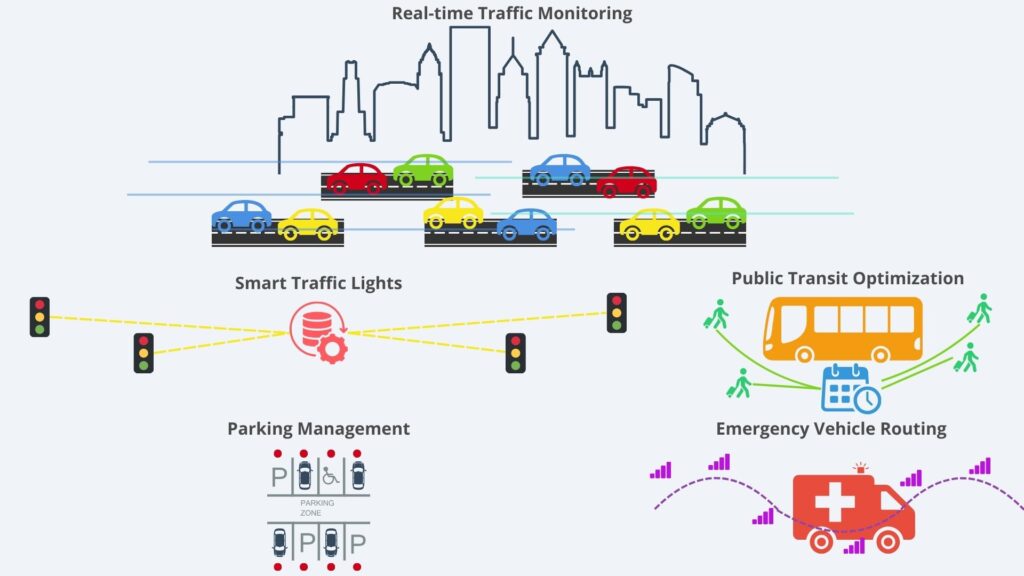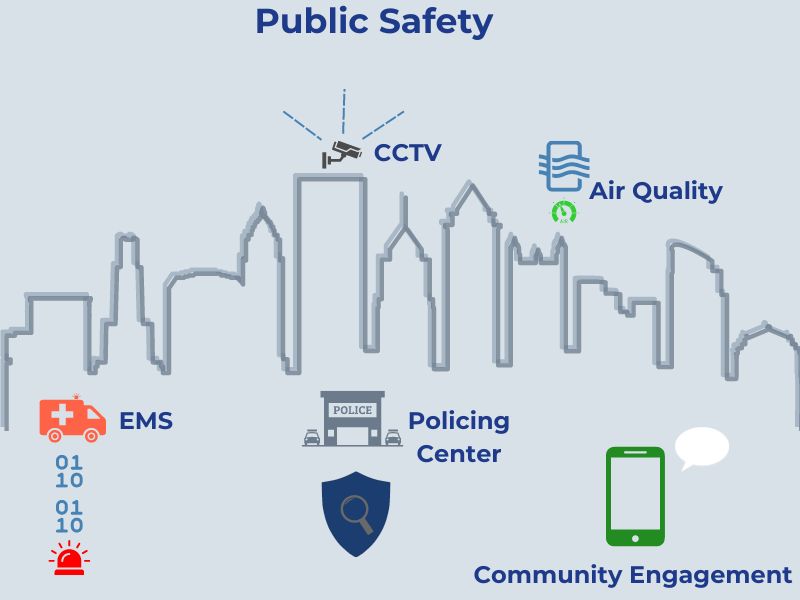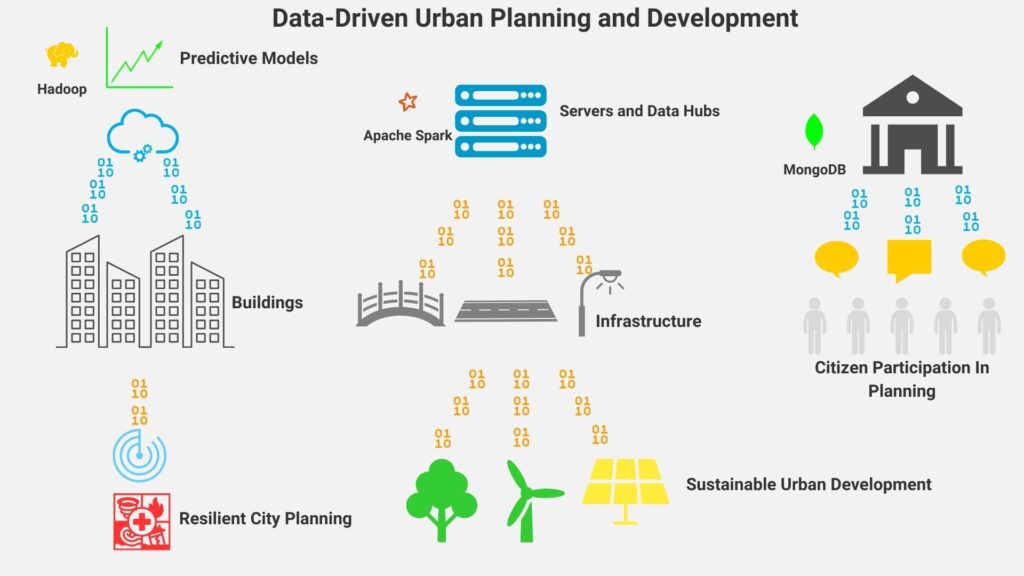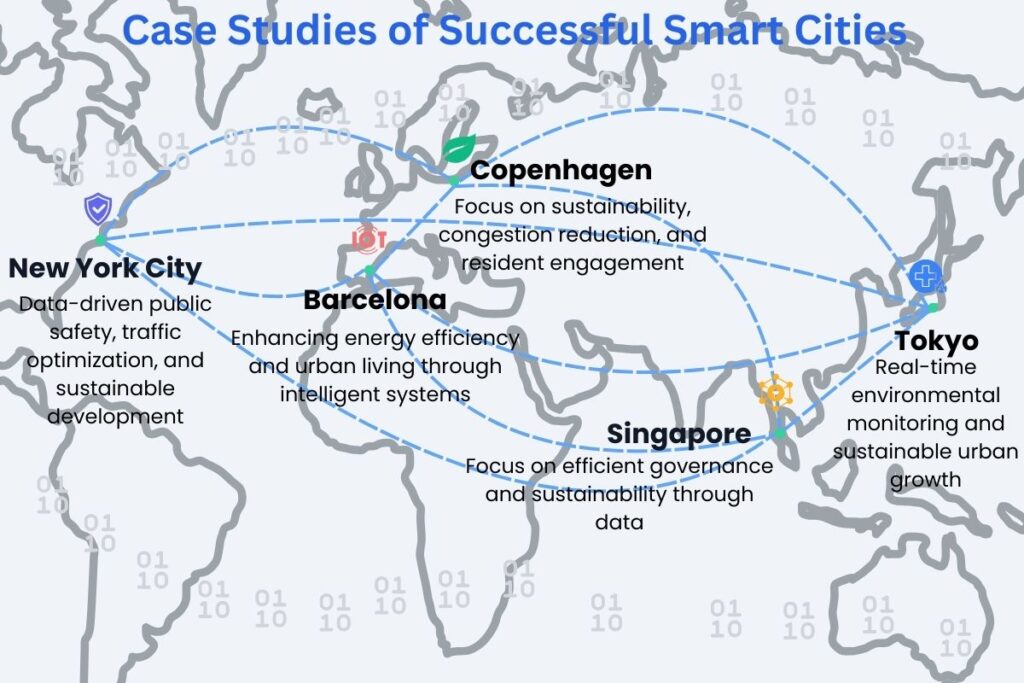Introduction: The Evolution of Smart Cities with Big Data
Over half the world’s population lives in cities, and urbanization will increase rapidly. Consequently, this has given rise to more intelligent and efficient city management in many essential areas. Primary focus areas include traffic management, energy efficiency, public safety, and urban planning. Cities can only achieve intelligent, efficient, automated management through data-driven planning and operations. They must use big data tools because these focus areas generate vast and diverse data. Cities are already adopting big data technologies to enhance urban living. This article explores how big data in smart cities is revolutionizing intelligent cities and improving the quality of life.
Section 1: Traffic Management in Smart Cities
Subsection 1.1: Real-time Traffic Monitoring
Many large cities suffer from congestion and traffic incidents that affect traffic flow. Improved traffic management will help alleviate congestion and enhance response to traffic incidents. However, traffic data across large cities is vast and diverse. This necessitates big data tools to utilize this data effectively for data-driven traffic management. Big Data in Smart Cities plays a crucial role in this process. They achieve this by enabling the integration and analysis of diverse data sources to optimize urban traffic systems.
IoT sensors and edge computing collect and preprocess real-time traffic data for further analysis. Big data storage manages data and its access through NoSQL databases and data lakes. Data streaming frameworks like Apache Spark allow the processing and analysis of vast traffic information in real-time. Finally, AI algorithms predict traffic patterns and optimize flow. However, local communities must take into account infrastructural costs and data privacy. Los Angeles is an example of using big data to reduce congestion.
Subsection 1.2: Smart Traffic Lights
Traffic lights play a crucial role in regulating traffic flow. However, the signal patterns only change when the time of day shifts or external interventions occur. The previous subsection considered real-time traffic monitoring. Cities can also utilize this data to adapt traffic light signaling in real time to improve traffic regulation significantly. Cities can also apply machine learning models to historical data to improve signal efficiency. Traffic management can also integrate motorists’ GPS readings for dynamic rerouting. This will reduce motorist idle times, reducing emissions and energy use. Barcelona has implemented intelligent traffic lights that have reduced travel time.
Subsection 1.3: Public Transit Optimization with Big Data in Smart Cities
Public transit is responsible for transportation within cities in addition to traffic. Cities can improve public transit through data-driven operations. Big data tools manage storage and access to vast, diverse public transit data collected in real-time. Apache Spark provides the framework for applying real-time analysis tools to public transit data. These tools include predictive analytics, dynamic scheduling, and passenger flow management. Predictive analytics forecast demand for public transportation, while dynamic scheduling adjusts routes and schedules based on public transit data. Passenger flow management analyzes transit data and uses predictive analytics and dynamic scheduling to improve efficiency. This allows public transit to optimize resources and reduce operational costs. Furthermore, public transit can take a greater share of transportation and alleviate traffic burdens, including congestion. London’s public transit system (“The Tube”) has successfully used big data to manage its cost and resource utilization.
Subsection 1.4: Parking Management with Big Data in Smart Cities
The following piece is about parking management because parking affects overall traffic patterns. Cities can augment their traffic management data with parking data collected by intelligent parking sensors. Parking management tools built on data streaming frameworks like Apache Spark optimize parking for motorists. They connect to a mobile app to provide motorists with real-time parking information and guide them to parking spots. The immediate benefit is that they reduce time spent searching for parking and thereby reduce overall traffic. Additionally, they assist cities in maximizing parking revenue through optimization algorithms. San Fransico has introduced an intelligent parking system to alleviate traffic congestion.
Subsection 1.5: Emergency Vehicle Routing
So far, we have only considered managing regular normal traffic with gradual pattern changes. However, traffic management must be flexible enough to manage traffic during extraordinary events or emergencies. Therefore, traffic management must integrate emergency data with existing traffic data. Big data storage makes this possible because it can integrate data from diverse sources. Traffic management requires predictive modeling tools built on frameworks like Apache Spark to anticipate traffic delays and suggest optimal routes. They also need to support priority signal systems that provide emergency vehicles with green lights based on their location. Finally, they need to deliver real-time traffic data to emergency services to allow them to make data-driven decisions. New York City has piloted EMS routing optimization for highly dense traffic conditions.

Section 2: Energy Efficiency in Smart Cities
Subsection 2.1: Smart Grids and Big Data in Smart Cities
Modern cities are responsible for delivering power to their inhabitants through energy grids. Traditionally, these grids have inefficiencies and unavoidable failures. Big data coupled with intelligent instrumentation can address these traditional issues through storage and applying analytics on grid data. Tools built on Apache Spark can monitor energy usage across the grid in real-time. They then provide input to demand response systems, which adjust energy distribution. These tools also help to reduce energy waste and operational costs, delivering cost savings. Other analytics tools perform predictive maintenance on grid data to anticipate and prevent grid failures. Tokyo has implemented a smart grid that has delivered energy efficiencies.
Subsection 2.2: Renewable Energy Integration
The renewable energy movement is continually making inroads into traditional power distribution. Energy storage systems have also progressed to becoming mainstream in the past year. Big data in smart cities allows for managing renewable energy and energy storage data. It also integrates this data with existing energy grid data. Analytic tools built on data streaming frameworks like Apache Spark predict energy production from renewable sources. They also analyze this data to manage storage solutions for storage optimization. These tools then integrate this with grid data to balance the grid and ensure a stable energy supply. This reduces reliance on non-renewable energy. Denmark has demonstrated the viability of renewable energy by integrating wind energy into its grid.
Subsection 2.3: Smart Metering
Cities can use intelligent metering systems to share data collected from the grid with consumers. This allows cities to provide consumers with real-time energy usage information. Analytics tools can support dynamic pricing models that adjust energy prices based on demand patterns. Other analytic tools analyze consumer behavior to enable cities to encourage energy-saving habits. These tools also support energy efficiency improvements for targeted energy conservation efforts. Italy has implemented a nationwide intelligent metering initiative demonstrating this technology’s intrinsic value.
Subsection 2.4: Building Energy Management Systems (BEMS)
Cities can extend grid data and intelligent metering to commercial buildings. Big data technologies can provide real-time occupancy data to automated energy controls, adjusting heating, cooling, and lighting based on occupancy. Analytics tools can derive data-driven insights that optimize building energy use for efficiency. Additionally, they can perform energy needs forecasting based on historical data. Subsequently, by reducing energy waste, they can lower operational costs. Singapore has implemented smart building management in commercial spaces to demonstrate this technology’s potential.
Subsection 2.5: Public Lighting Management
Public lighting is a significant load on cities’ energy grids and energy supply. Cities can integrate data associated with public lighting with big data systems handling energy grid data. This data includes weather conditions and real-time lighting data from lighting IoT devices. Analytic tools on real-time streaming (e.g., Apache Spark) can adjust brightness based on this data. Furthermore, they can perform energy consumption analysis to optimize public lighting schedules. Next, they enable predictive maintenance to reduce downtime and costs. Amsterdam provides a valuable case study with its smart lighting project.

Section 3: Enhancing Public Safety with Big Data
Subsection 3.1: Predictive Policing
Public safety is essential for cities with limited policing resources, and they need to implement proactive measures. Crime data is vast, diverse, and unstructured; big data in smart cities is necessary to manage this data. This includes NoSQL databases and datalakes to make this data accessible to analysis tools. Big data batching frameworks like Hadoop analyze historical crime data to predict potential hotspots. AI analysis tools identify patterns and trends in criminal activity. These data-driven insights and strategies optimize police deployment and help prevent crimes. Los Angeles’ predictive policing program has pioneered these techniques.
Subsection 3.2: Big Data in Smart Cities: Surveillance and Monitoring
Public safety activities need to monitor many places that are beyond the capabilities of human presence. Video surveillance and inexpensive data storage allow cities to process real-time video feeds. Sophisticated video analytics tools can detect suspicious activities, alerting law enforcement. In addition, facial recognition systems can identify individuals in real-time. Big data tools make crowd management data-driven to control large gatherings and prevent incidents. However, cities must balance public safety with privacy rights, making this a highly politically charged activity. London has pioneered an extensive CCTV network in the wake of terror attacks.
Subsection 3.3: Emergency Response Systems
Public safety also entailed effective response to any public emergency and increased effectiveness by making it data-driven. Cities can extend big data management of public data outlined above to include data sourced from emergency services. This allows emergency services to share real-time data to enhance coordination. AI tools operating on this data can provide real-time suggestions for emergency services. Public safety agencies can collect real-time data for analysis tools to predict natural disasters, allowing for their preparation. These data-driven strategies improve emergency services response times. Tokyo is in an earthquake zone and has implemented an earthquake response system.
Subsection 3.4: Environmental Monitoring
Public safety also includes public health impacted by pollution. Public health agencies need big data because air and water quality data are vast, diverse, and changing in real-time. Big data tools include NoSQL databases and data streaming frameworks like Apache Spark. NoSQL databases support diverse real-time data provided by air quality sensors. These sensors monitor and report pollution levels in real-time. Data streaming frameworks support real-time analytics tools that identify pollution sources and trends. AI tools then provide data-driven insights to shape public health policies. Beijing has experienced massive air pollution and has implemented air quality improvement initiatives.
Subsection 3.5: Community Engagement Platforms
Adequate public safety must involve citizens’ active participation in reporting issues and providing feedback. However, this data is vast and unstructured, and public safety needs big data tools to manage it. Therefore, these tools include distributed databases and log data structures. Examples of distributed databases include Cassandra and MongoDB. AI tools are beneficial in analyzing feedback to identify trends in community concerns. Additionally, encouraging citizens to participate and act on their input increases trust between residents and city officials. New York City has implemented the 311 system for citizen participation.

Section 4: Urban Planning and Development
Subsection 4.1: Data-Driven Urban Planning
Cities must anticipate and plan for future development and provide present services. Making urban planning more data-driven will help to better anticipate and plan for this development. To achieve this, big data tools in smart cities store and batch process vast and diverse urban data. Storage tools include HBase since analysis is batch-driven to derive reliable insights. Hadoop supports batch processing frameworks to build predictive models, AI tools, and scenario simulators. Predictive models forecast urban growth and infrastructure needs, while AI tools analyze data to optimize land use and zoning decisions. Scenario simulators support testing different urban development strategies using collected data. Urban planners can also focus on sustainability to promote eco-friendly urban designs. Singapore has adopted a data-driven urban planning approach, which makes it a practical case study.
Subsection 4.2: Smart Infrastructure Development with Big Data in Smart Cities
Aside from services, cities are also responsible for building and maintaining infrastructure. Moreover, big data technologies support gathering, managing, and processing vast, diverse infrastructure data in real-time. Cities can further make IoT-enable infrastructure for existing and new infrastructure to collect data to monitor and manage that infrastructure. Consequently, Big data tools support storing, integrating, and processing real-time and batch data for comprehensive infrastructure management. These tools include NoSQL, HBase, Apache Spark, and Hadoop. Apache Spark supports real-time data processing tools that process data to anticipate and prevent infrastructure failures. Hadoop supports batch-processing analytic tools that enable cities to use materials and energy efficiently in infrastructure projects. For example, Barcelona has demonstrated smart infrastructure initiatives.
Subsection 4.3: Citizen Participation in Planning
Citizen participation is essential for any successful urban planning initiatives. Therefore, big data tools can provide citizens access to urban planning data. With unstructured data storage tools, big data can also integrate residents’ feedback into existing urban planning data systems. An example is a document database like MongoDB. Consequently, AI analysis tools can analyze residents’ feedback to identify key community needs and preferences. Thereby, cities can ensure that urban planning reflects the needs of all citizens. An example is Boston successfully implementing a participatory urban planning platform.
Subsection 4.4: Sustainable Urban Development
Cities now aim to achieve sustainability goals with every urban development initiative. Subsequently, they must integrate sustainability and environmental data with their existing data-driven urban planning platforms. Additionally, they need batch-processing analysis tools to optimize building resource usage, energy efficiency, and waste management. For building management, these tools must optimize the design and construction of sustainable buildings. Urban development projects need other analysis tools to assess their energy impact. At the same time, cities require different tools to optimize waste collection and recycling using urban data. Cities also need climate modeling tools to predict urban project’s climate impact. A practical case study is Copenhagen’s sustainable urban development strategies.
Subsection 4.5: Resilient City Planning with Big Data in Smart Cities
In addition to emergency services support, cities should include resiliency in urban planning. Both real-time and batch processing of urban data will make resiliency data-driven. Batch processing disaster risk analysis tools analyze diverse urban data to identify and mitigate urban vulnerabilities. Other analysis tools allow engineers to design buildings and systems to withstand environmental impact, creating adaptive infrastructure. Real-time processing continually assesses urban resilience factors from real-time data. Furthermore, these platforms engage citizen participation by providing access to resilience planning and accepting and analyzing citizen feedback. New Orleans is an excellent example of implementing resilience strategies after Hurricane Katrina.

Section 5: Case Studies of Successful Smart Cities
Subsection 5.1: Singapore – A Global Leader in Smart City Innovation
Singapore is a global leader in smart city innovation, leveraging big data for efficient governance. The city optimizes public transportation and traffic flow through data analysis. It also enhances energy efficiency with smart grid technologies and improves public safety using predictive policing and surveillance. Data also plays a key role in urban planning, helping design sustainable and resilient spaces. Singapore’s data-driven approach exemplifies how cities can harness technology to improve quality of life.
Subsection 5.2: Barcelona – Smart Infrastructure and Urban Living
Barcelona utilizes smart infrastructure for urban living by using big data to improve public services and resident engagement. It has integrated IoT for real-time city infrastructure monitoring and enhances energy efficiency through intelligent systems. It has also implemented smart traffic management to reduce congestion while focussing on sustainability through data-driven projects.
Subsection 5.3: New York City – Data-Driven Public Safety and Services
New York City is pioneering data-driven public safety and services and is reducing crime through data analysis and AI. It also set up the 311 System to engage residents in city management through a data-driven platform. New York City also uses big data to optimize traffic flow and reduce congestion. Meanwhile, it is leveraging data to monitor and improve public health. Additionally, it employs data-driven strategies for sustainable development.
Subsection 5.4: Tokyo – Integrating Technology with Urban Life
Tokyo has successfully integrated technology with urban life in several key areas. Because it is in an earthquake zone, it uses big data to improve its response to natural disasters. It has also implemented smart grids to enhance energy efficiency and reliability in urban areas. In addition, Tokyo is using data analytics to optimize public transportation. It is using data for both environmental monitoring and sustainable development. It tracks real-time air quality and environmental factors while focusing on data-driven, eco-friendly urban growth.
Subsection 5.5: Copenhagen – Leading in Sustainability and Smart Growth
Copenhagen has focused on leading in sustainability and smart growth through sustainable urban development and energy efficiency. It achieves this by employing data for green buildings and eco-friendly infrastructure and implementing smart grids and renewable energy systems. Copenhagen also uses data to reduce congestion and promote cycling, enhancing safety through data-driven strategies. Finally, it involves residents in city planning through data platforms.

Conclusion: The Future of Smart Cities and Big Data
In conclusion, big data is a key enabler of smart city initiatives, driving improvements in traffic management, energy efficiency, public safety, and urban planning. Cities that leverage data analytics can optimize resources, reduce costs, and enhance the quality of life for their residents. As urbanization continues, the role of big data will only become more critical in shaping future cities, ensuring they are more sustainable, resilient, and responsive to the needs of their populations.


